I’m recently back from a journey that took me through Russia, Mongolia, China, Tibet, and Nepal (and I’m aware that China considers Tibet an “autonomous region” of China and not a nation in its own right; that China “liberated” Tibet 60 years ago. But nobody - absolutely nobody in their right mind and not brainwashed by the chinese dictatorship - can see the ruthless chinese oppression of Tibet as anything else than a blatant occupation! More on that in an upcoming post).
I visited Russia (Siberia) during very early spring and my photos from that part of the trip mainly boils down to those of leafless birch trees; so I’ll skip Russia and jump straight to Mongolia in this floristic travelogue ;-) I’m in the unfortunate situation that I don’t know the names of most of the plants featured in this post so any help is appreciated ;-)

Cream flowers

Yellow flowers

Light blue / lilac flowers
After spending some days in Ulan Bator (Ulaanbaatar), the capital and largest city of Mongolia, we set out for Gorkhi-Terelj National Park. It was still early spring but a few plants were flowering, including the cream, yellow, and light blue/lilac flowered plants pictured above. Especially the latter was abundant, in many places almost covering the grassy slopes with its beautiful flowers.
My expectations to Gorkhi-Terelj involved imagery of serene, unperturbed nature allowing for days of pure trekking bliss ;-) However the “developed” part of the park we visited is on the verge of being destroyed by golf courts, tourist ger camps, ubiquitous signs and posters, road construction, housing development, and the like. In their eagerness to attract more visitors the very soul of what people are coming to see are being destroyed. It’s a big shame.
That being said it’s still possible to find undisturbed spots among the rolling, grassy hills and beautiful rock formations (in many ways reminding of the monzogranite formations at Joshua Tree National Park) where you can get a sense of being in the wilderness. If you are of an imaginative temperament it’s not even hard to envision Genghis Khan (Chinggis Khaan) galloping across the steppes; otherwise you can go see the (quite clumsy and ugly, yet colossal) Genghis Khan monument ;-)
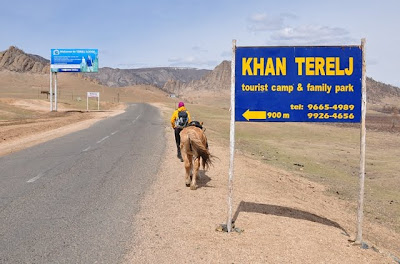
A few of the ubiquitous signs and posters

Road construction near Turtle Rock
Another plant that is abundant in Terelj is (what I take to be) Orostachys spinosa, a cold-tolerant alpine native to Siberia and Mongolia. Its fleshy leaves are arranged in a rosette, growing to 10 cm (4'') in diameter at maturity. The plant is said to be able to survive extreme freezing temperatures down to -40°C. I collected a few of these plants in the hope to grow them on my balcony here in Copenhagen, but unfortunately most of them died off in a storage room in Kathmandu - one small plant is still alive though, so I keep my hopes high ;-)
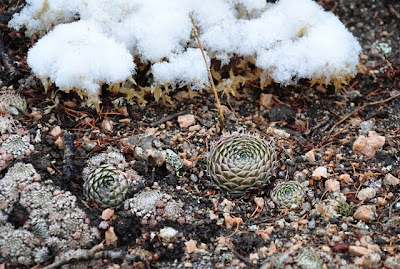
A cluster of Orostachys spinosa
Back in Ulan Bator the only plants we could find were made of plastic. At first I found it a bit strange to have outdoor plastic flower arrangements in a park, but it seemed like a common practice.

Red plastic flowers
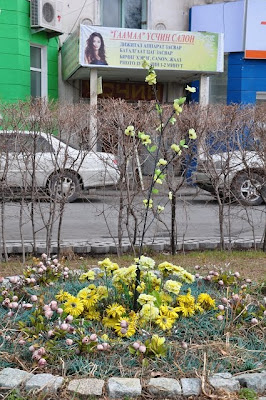
Yellow plastic flowers
Monday, July 04, 2011
Mongolian wildflowers
Wednesday, March 30, 2011
Non-cactus flora of Joshua Tree National Park
Unfortunately I’m not that well versed in the non-cactus flora of the Mojave and Colorado deserts so I’m afraid I don’t know the names of most of the plants featured in this post. If you have more details I would appreciate a comment.
Unknown blue flower in habitat
I was especially fascinated by this small plant growing in the lower Colorado portion of the Joshua Tree National Park. I visited too early in the spring to experience a full blooming desert but this guy was flashing its bright blue flower, standing out among all the earth tones amidst a wash crossing the trail from Cottonwood Spring to Lost Palm Oasis. I studied the plant and its surroundings for a while, intrigued by the habitat it had chosen to grow in - it would for certain be washed away by torrents of water during the next flash flood.
Unknown yellow flower
Another interesting plant displayed this beautiful yellow flower that looks like it might belong to the Fabaceae (Leguminosae) family but I’m not certain.
Unknown yellow flower in habitat
The yellow flowered plant had found a much more secure habitat, growing safely among the boulders in the rock-enclosed Hidden Valley (rumored to have been used by cattle rustlers in the past).
Nolina parryii in habitat
One species I’m pretty sure of is Nolina parrayii (Parry's Nolina or Giant Nolina) that has long thin leaves (and is sometimes called beargrass). It seems to be especially abundant in the lower Colorado portion of the park but also grows in some of the higher Mojave parts like e.g. the aforementioned Hidden Valley.
Nolina parryii seeds
Its tall flower stalk is said to be edible after being baked, with a somewhat bitter taste. Alas, no fresh flower stalks were to be found at the end of February and I didn’t want to try the old dry ones out for taste ;-)
In order to be better prepared I plan to buy the following desert flora books before my next visit to Joshua Tree National Park: Sonoran Desert Wildflowers
Sunday, April 05, 2009
Ramsons covering the forest floor
This post is very much off the usual topic – now you are warned ;-)

Ramsons basking in the spring sun
Spring has finally arrived in Denmark and is being heralded by one of its early messengers: ramsons. Ramson (Allium ursinum) (also known as buckrams, wild garlic, broad-leaved garlic, wood garlic, and bear's garlic) is a wild relative of chives and grows in deciduous woodlands – fortunately such a forest is located only a couple of kilometers from where I live.

Ramsons covering the forest floor
Ramson is easily distinguished from other plants of the forest by the distinctive, garlicky smell of its leaves. On calm warm days, during the ramson season, the whole forest is enveloped in a cloud of mild garlic odors. When the plants flower the smell can grow really intense – some might even refer to it as a pungent stench ;-)
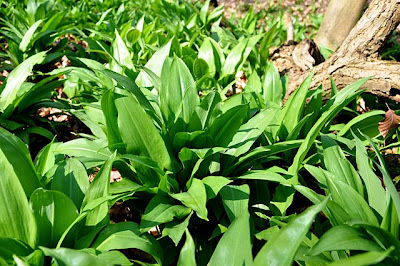
Carpet of ramsons

Ramson leaves, close-up
When not flowering, the extremely poisonous Lily of the Valley (Convallaria majalis) might be mistaken for ramsons – fortunately you can tell ramson by its smell ;-) All parts of ramson are edible and make for a great supplement to your spring menu.

Lesser celandine flower, close-up
Another messenger of spring in many Danish deciduous forests is the lesser celandine (Ranunculus ficaria (syn. Ficaria verna)) (also known as fig buttercup, and fig wort). Their extremely shiny, looking almost plastic-like, yellow flowers and lustrous dark-green heart-shaped leaves make these plants stand out on the spring forest floor.

Lesser celandine
Last but not least, I must mention the white anemone (Anemone nemorosa) (also known as wood anemone, windflower, thimble weed, and smell fox) – in select locations the anemones virtually blanket the forest floor.

Wood anemone flower, close-up

Wood anemone blanket

Flowering wood anemones
In a few weeks the canopy will be covered in foliage again – until then the dwellers of the forest floor rule.

Forest overlooking the Aarhus bay
Update - May 11, 2009
The deciduous forest is now almost fully leafed-out and it is time for the ramsons to flower.
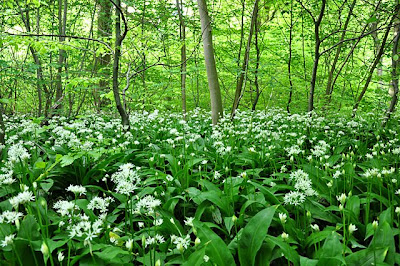
Flowering ramsons covering the forest floor
The older leaves tend to have a more pungent smell than the small, younger ones and if you trample through a stand of flowering ramsons the garlicky odor can be really overwhelming.
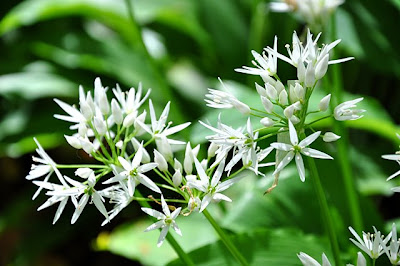
Ramsons flower, close-up
As all other parts of ramsons the flowers may also be eaten and are said to make an interesting garnish for salads – I haven't tried that though.
All Time Most Popular Posts
-
Lophophora williamsii (peyote) populations have diminished in large areas of South Texas where peyoteros harvest the cactus for ceremonial ...
-
On various occasions I've been asked what growing media I'm using for my cactus plants. I don't have a set soil mix recipe as su...
-
Below is a list of retailers/nurseries selling cactus seed and plants. I've only listed vendors I've done business with. If you ar...
-
Most cacti are easily grown from seed - and with a little patience and care they can be grown into beautiful plants. Lophophora williamsi...
-
In last month’s post on the troubled Texan peyoteros I referred to Anderson’s article on the peyote situation in Texas. Given the importanc...
-
Yet another slightly off topic and probably not entirely politically correct post, but I couldn’t help noticing the similarity of my monstr...
-
Flowering stand of San Pedro cacti (Trichocereus pachanoi) To me the main draw of the San Pedro cactus ( Trichocereus pachanoi (syn. Ech...
-
In the June 2008 issue of the Cactus & Co magazine Jaroslav Šnicer, Jaroslav Bohata, and Vojtěch Myšák described a new Lophophora spec...
-
There seems to be an increased focus on the alarming Texas peyote situation. A couple of weeks ago the Houston Press published a mournful, i...
-
I spent two weeks working in Delhi, India during January. I had one weekend off and had planned to spend it in Delhi at my own leisure, but ...
























